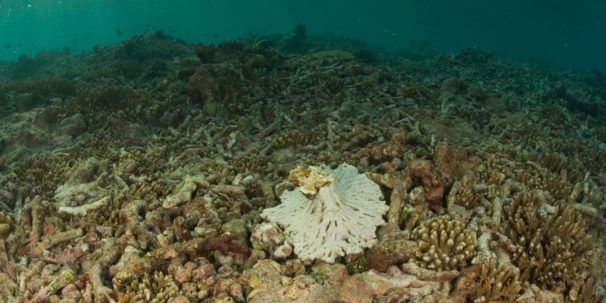Everything you need to know about climate change in Australia
We take a detailed look into Australia’s climate, the effects of global warming on climate change in Australia, and what the Australian Government is doing to combat greenhouse gas emissions by 2050.

An introduction to climate change in Australia
The impacts of climate change in Australia, as well as globally, are being felt and are likely to continue and intensify.
These changes are largely attributed to emissions of greenhouse gases due to human activity.
It’s suggested that if sustainable action by the Australian government is not taken to reverse the changing climate, some shifts will be catastrophic, as well as irreversible.
There’s also increasing recognition around how climate change will affect Australia, such as restriction of agricultural growing seasons, intensification of bushfire conditions, increased drought, hotter summers, and fewer cold days.
Overall, global warming in Australia poses serious pressure on human wellbeing, economic activity, community safety, and the sustainability of natural ecosystems.
Through this article, we will explore in more detail how the climate in Australia will continue to be affected, what the Australian Government is doing about climate change, plus the plans and policies it has in place to tackle the future projections of climate change.
Australia’s climate zones
Australia has a wide variety of climates, throughout the eight states and territories, due to its large geographical size and position.
Australia’s climate is largely affected by the El Niño–Southern Oscillation, which is the reason for its extensive droughts, dust storms, bushfires and considerable frosty wet periods.
Largely, the Australian climate is an arid climate, classified as desert or semi-desert. The exception is in the extreme north, where the weather is tropical, with a rainy and a dry season. On the southern coasts, it’s more Mediterranean.
Located in the southern hemisphere, Australia’s summer is December to February; March to May is autumn; June to August is winter, and September to November is spring.
Specifically, the climate in desert areas such as Alice Springs, popularly referred to as the outback, is arid or very hot and dry in summer, with some days experiencing temperatures as high as 50°C. Surprisingly, the outback can experience below-freezing temperatures during the winter months.
In the two southern areas, Perth and Adelaide, the climate has a Mediterranean vibe, with mild, cool, rainy winters and warm, dry summers.
In the northern areas, Darwin, Cairns and Brisbane, the climate is tropical, with a dry, sunny season and a rainy and muggy season. The tropical rains mostly occur in the form of downpours or thunderstorms in the afternoon or evening.
Because Brisbane is located in the south-eastern part, the climate is more subtropical, with warm or hot weather for most of the year. Wintertime is generally dry and mild.
In the south-east, Canberra, Sydney and Melbourne, enjoy a temperate climate with warm to hot summers; mild, temperate springs and autumns; and cool winters, with rainfall spread evenly throughout the year. Melbourne has the reputation for its changeable weather, often referred to as having “four seasons in one day.”
The effects of climate change in Australia
Climate change data and statistics including future projections for Australia are frequently reported by the Australian Government Bureau of Meteorology, and the Commonwealth Scientific and Industrial Research Organisation (CSIRO).
According to the 2020 State of the Climate Report, produced every two years, most of the seasonal changes observed over the last six decades will continue right into the future, unless prevented.
The two main human activities that are contributing towards climate change are emissions of greenhouse gases and aerosols, plus land use and land conversion practices.
As of 2020, the biggest source of greenhouse gases in Australia were emissions during the combustion of fossil fuels to generate electricity. As of June 2020, greenhouse gas emissions had already reached 251 million metric tons of carbon dioxide equivalent.
In turn, the total area of land under primary production in Australia – livestock grazing, dryland and irrigated agriculture, is nearly 4.6 million square kilometres or 59 per cent.
Five ways Australian climate change has manifested
1. Rising sea temperatures
Climate change has meant that Australia’s Great Barrier Reef is at greater risk of heat stress and coral bleaching. These two factors mean that the unique sea life of Australia’s coast could be in danger. Other factors, such as ocean acidification, are also being observed as a result of global and Australian climate change.
2. Overall temperatures
Since 1950, every decade has been warmer than its predecessor. The seven years from 2013 to 2019 all rank in the nine warmest years, with extreme heat events and increased drought conditions.
This long‑term climate change trend means that most years are now warmer than almost any observed during the 20th century.
Increases in temperature are observed across Australia, in all seasons, with both day and night-time temperatures showing warming. For example, 2019 experienced 43 extremely warm days, more than triple the number in any of the years prior to 2000.
3. Fire weather
There has been a long-term increase in extreme fire weather and in the length of the fire season across large parts of Australia since the 1950s.
The Forest Fire Danger Index (FFDI) has increased in recent decades across many regions in Australia, predominantly in southern and eastern Australia. Climate change, including increasing temperatures, is associated with the increase in the length of the fire weather season.
4. Rainfall
In 17 of the last 20 years, rainfall in southern Australia April to October rainfall across south-eastern and south-western Australia has declined, resulting in dryer conditions. This is largely caused by increased anthropogenic greenhouse gas emissions.
In the southeast of Australia, the intensity of short-duration extreme rainfall events has increased by around 10 per cent or more in some regions. Short-duration extreme rainfall events are often associated with flash flooding, which brings increased risk to communities. This is particularly so in urban environments, where a large amount of concrete leads to increased flooding during heavy downpours.
5. Water streamflows
The observed long-term reduction in rainfall across southern Australia has led to even greater reductions in streamflows, the flow of water in streams, rivers, and other channels.
6. Snow
A downward trend in snow depth has been widely observed for Australian alpine regions since the late 1950s.
Snow depth is closely related to maximum temperatures, and the observed declines are associated with the long-term trend of increasing temperatures.






What is the Australian government doing about climate change?
When it comes to Australia’s climate change policy, according to the Sustainable Development Report, Australia unfortunately scored last of 193 United Nations member countries, for action taken to reduce global greenhouse gas emissions.
A database indicates how Australia received a score of just 10 out of 100 in an assessment of fossil fuel emissions, emissions associated with imports and exports, and policies for pricing carbon.
On a positive note, the Australian Federal Government’s current target climate policy under the Paris Agreement is to reduce emissions by 26 to 28 per cent on 2005 levels by 2030 – targets it seems it’s in line to meet. Australia has also hinted that it may adopt a net-zero greenhouse gas (GHG) emissions target by 2050.
To achieve this and monitor progression, Australia has climate change policies and legislative regimes across the States and Territories with respect to emissions reduction, renewable energy, and energy efficiency by 2030.
The Climate Solutions Package is a $3.5 billion investment to deliver on Australia’s 2030 Paris Agreement commitments, building on existing climate change mitigation policies and programs. Our course Sustainable Cities: Governing Urban Adaptation Under Climate Change, can help you develop a plan on how to fund and implement sustainability in urban areas.
A central climate plan is the Emissions Reduction Fund (ERF), whereby the government puts forward incentives for Australian businesses to cut the amount of greenhouse gases they create, and to undertake activities that store carbon. These include new technologies, upgrading equipment, changing the way vegetation is managed, and new business practices.
In return, participants can earn Australian Carbon Credit Units (ACCUs) for every tonne of emissions reduced or stored through a project. Businesses can then sell ACCUs, to the Australian government through an auction, to generate income.
The six areas upon which Australia’s climate policies are focused
1. Transport
The transport sector accounts for 16 per cent of Australia’s greenhouse gas emissions. Solutions include the use of electric cars, low-carbon transport and changing the way people and freight are moved.
2. Industry
Industrial emissions have been increasing since the 1990s, being dominated by the mining, oil and gas sectors.
Participation in the ERF to reduce emissions, and clear trajectories to reduce industrial processes that contribute towards emissions, are being put in place.
3. Electricity
Emissions from the electricity sector are the largest source of emissions in Australia, at 34 per cent of the total. Emphasis is on renewable projects that align with priorities identified by the Australian Energy Market Operator. To learn more about renewable energy sources our course, Renewable Energy Transition will help you get started.
4. Agriculture and land
There is significant potential for the land sector to contribute to achieving Australia’s long-term emission reduction goals through holistic management approaches, by reforesting and regenerating the land for a better and more sustainable food system.
5. Waste
The waste sector makes up about two per cent of Australia’s total emissions, with the majority coming from the decomposition of organic matter at landfills. The current state and territory regulatory approaches to reducing landfill gas emissions, include diverting organic waste from landfills and fully implementing the National Food Waste Strategy.
6. Energy efficiency
Australia’s performance compared with other developed nations is poor on energy efficiency, being ranked as 18th of the top 25 energy using countries. Policies include investing in improving the energy efficiency performance of existing buildings, both privately and Government-owned including in small to medium businesses.
Future predictions: How will climate change affect Australia?
It’s predicted that if Australia doesn’t curb climate change by 2050, it will experience some very challenging and uncomfortable living conditions. Potential issues include a greater risk of illness, economic turmoil, the destruction and extinction of ecosystems, extreme weather conditions and ferocious bushfires.
A visual data tool created by ANU Climate Change Institute, to communicate the impacts of climate change in a way that people can better understand, shows that by 2050, Australians will no longer enjoy winter as they know it today. Instead, they will experience a new season, which the designers are calling “New Summer”.
New Summer represents a period of the year where temperatures will consistently peak, in many cases well above 40ºC, for a sustained period.
Temperature projections from the national science agency CSIRO and the Bureau of Meteorology, state there is very high confidence that the average temperature is set to be up to 1.3ºC warmer in 2030 compared with the average experienced between 1986 and 2005. The climate change science is undeniable.
Projections depend on reducing greenhouse gas emissions. If not, and emissions remain high Australia could experience a temperature increase of between 2.8ºC and 5.1ºC by 2090.
Overall, the CSIRO’s future climate projections suggest that for Australia:
- hot days will become more frequent and hotter
- sea levels will rise
- oceans will become more acidic
- snow depths will decline
- extreme rainfall events will become more intense
Final Thoughts
Despite the Australian Government not doing enough to meet all past climate goals, it seems it’s renewing its commitment to climate change, through incentives and new policies, to reach its goal of reduced emissions by 26 to 28 per cent by 2030.
Polling released by The Australia Institute shows the effects of climate change in Australia and its impacts remain a prominent concern to Australians, even amid the upheaval and uncertainty wrought by COVID-19.
When it comes to energy sources and their overall contribution to climate change, the solution seems obvious. Electricity generation contributes 32.7 per cent of Australia’s emissions. The Climate of the Nation report shows the vast majority, 83 per cent, want to see coal-fired power stations phased out.
Furthermore, seventy-one per cent want Australia to be a global leader in finding solutions to climate change, while 77 per cent recognise tackling climate change can create opportunities for new jobs and investment in clean energy.
A new University of Adelaide survey found that one in five Australians are making a conscious effort to reduce their consumption of meat for health and environmental reasons.
On the whole, the Federal Government and Australians are well aware of climate risks and must be willing to support sustainability and climate action. Together, we can all make a difference.
To find out more about the causes and impacts of climate change, you can check out our climate change courses. These can enable you to tackle the climate crisis and unleash your potential as a changemaker for sustainable futures.






